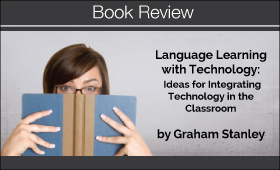Book Review: Language Learning with Technology: Ideas for integrating technology in the classroom
 By Adrienne Gonzales, PhD, Foreign Language Pedagogy & Technology Specialist at University of Denver, CO.
By Adrienne Gonzales, PhD, Foreign Language Pedagogy & Technology Specialist at University of Denver, CO.
DOI: https://doi.org/10.69732/HCUC1538
Language Learning with Technology: Ideas for integrating technology in the classroom by Graham Stanley is a handbook for new and experienced teachers who seek to take advantage of various technologies to improve and enhance their teaching practice and students’ experience.
THE PURPOSE OF THIS HANDBOOK, AS STANLEY STATES, IS:
- To provide a wide range of interesting and useful activities, where technology has been used only when there is clearly added value to language learning and practice.
- To show how any teacher can use technology, alongside an existing language course, to enhance language learning.
- To offer a reserve of activities which are suitable for all levels of proficiency, from beginner to advanced,m and which include ideas for listening comprehension, grammar, practice, oral production and fluency practice, amongst others (p. 6).
In the introduction, Stanley provides a brief review of literature illustrating the many affordances of technology for language teaching and learning and highlighting the rapidly evolving nature of this field. He describes a principled approach to language instruction which requires teachers to consider the how and when for technology integration and calls for training to help teachers take advantage of available tools. This book is intended to help bridge the gap between what institutions expect teachers to know in order to effectively use technology and what they actually know. Stanley warns of the trap of the ‘wow factor’ wherein teachers lose sight of pedagogy and are distracted by flashy new technology. To combat this temptation, he prioritizes pedagogy over technology by organizing the content of this handbook around learning goals, rather than different types of technologies.
Graham’s handbook is filled with activity plans written with beginning to advanced, adult English language learners in mind, but these activities are intended to be applicable or adaptable for all ages and foreign/second language contexts. He includes chapters on Integrating technology, Building a learning community, Vocabulary, Grammar, Listening, Reading, Writing, Speaking, Pronunciation, Project work, and Assessment and evaluation. Each of these sections opens with a short introduction which briefly describes the learning objective and the types of activities presented. Each activity plan outlines the main goals, level, time, learning focus, preparation, and technical requirements, then describes the activity in a procedure section. Many activities also include a variation section to assist teachers in re-envisioning and modifying the activity to alter the goals, level, etc.
The handbook offers two appendices for additional resources. In Appendix A: Learning technologies guide and Appendix B: Technical notes and suggested software/website by chapter, Stanley provides additional information and recommendations regarding the learning technologies referenced in the book. The book is also accompanied by a website: http://languagelearningtechnology.com/. At present, the site remains unfinished, but it has potential to be an excellent auxiliary resource for teachers. The site could be particularly helpful as a supplement to this handbook if the author were to use the space as a forum for discussing how these activities might fit into the curriculum at large. The extended collection of activity plans presented in this book could be pedagogically stronger with some additional information as to what place these activities hold within a larger course plan. It would also be beneficial to hear some ideas about how to most effectively fit these activities into existing curricula that might already struggle with issues of time, strict institutional requirements or limitations, etc.
Since there is no one-size-fits-all in language teaching and learning, it may be challenging for teachers with varying resources and class dynamics to adopt Stanley’s activities as-is. These activities do, however, serve as thought-provoking examples that might inspire teachers to adapt and apply to their unique circumstances and needs. Overall, this is a very helpful and accessible guide for teachers looking to expand their instructional repertoires.

